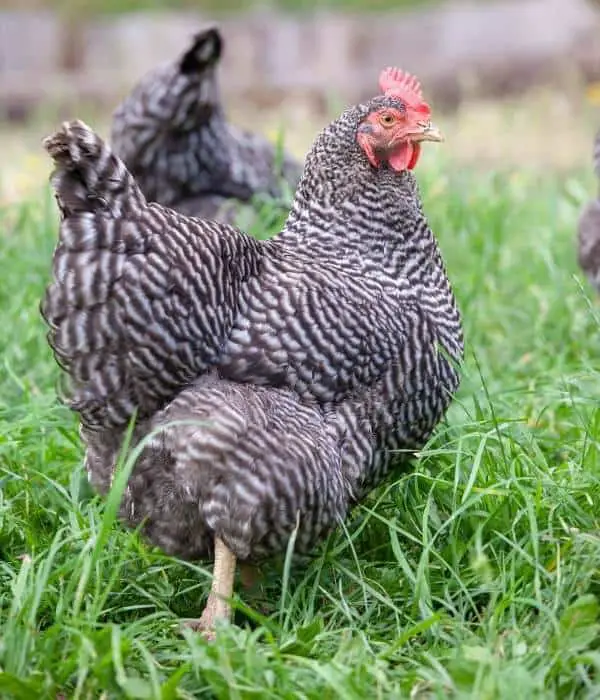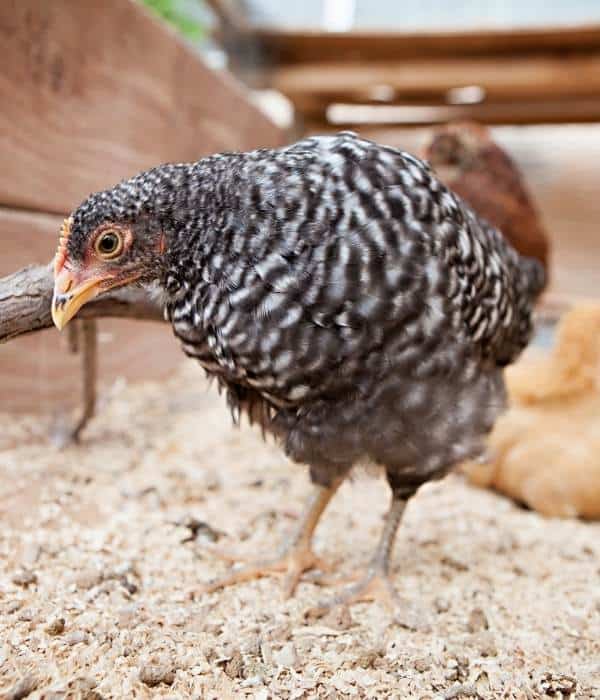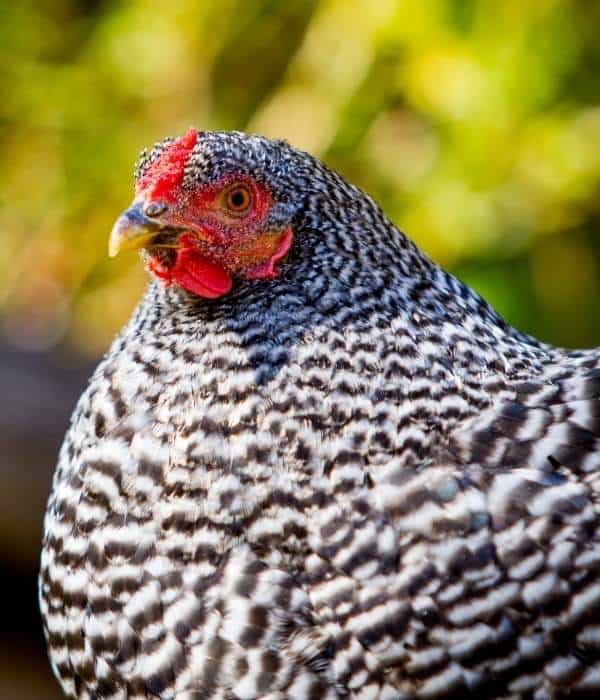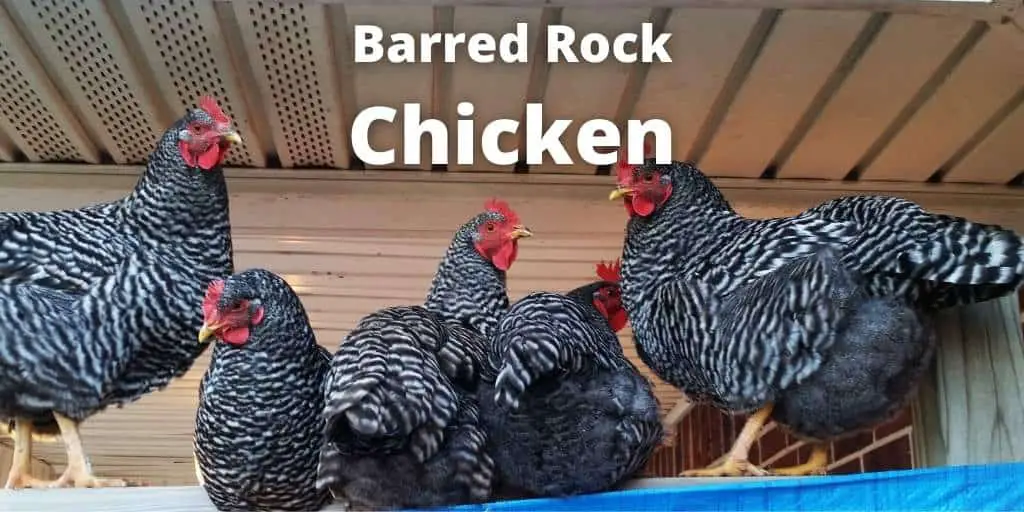Are you interested in adding Barred Rock chicken to your flock? Then, you’ve come to the right place. It is the most popular variety of Plymouth Rock Chicken.
You can get the complete information about Barred Rocks in this article. It is an excellent chicken that is well-known for its egg-laying capability. Here is the list of the best egg-laying chicken breeds.
Here, you will find all the information you need about the Barred Rock chicken, such as its history, color, size, appearance, benefits of raising it, and the problems you may have while raising it.
Before you buy a few Barred Rock chicks, I recommend you go through this complete breed guide to learn all the details.
Also read: Top 10 Best Rooster Breeds
What is Barred Rock Chicken?

The Plymouth Rock Chicken (Barred Rock Chicken) is a popular poultry breed. This breed is known for being hardworking and one of the most productive chicken breeds.
The Barred Rock Chicken is well-known for its superior egg-laying ability and gorgeous plumage. This chicken breed’s white and black stripes make it an American favorite.
To develop this breed, Dominiques and Black Javas were crossed in New England in the mid-1800s. The average weight of this bird is 7 to 8 pounds.
A single five-pointed comb, yellow skin, and black and white feathers with horizontal stripes define the Barred Rock Chicken.
They are friendly children who get along well with kids because many like to be held and cuddled.
What is the Difference Between Barred Rock and Plymouth Rock Chickens?
Barred Rock Chicken is a variety of Plymouth Rock Chicken. Other recognized varieties of Plymouth rock include black, black frizzle, blue, buff, Columbian, partridge, silver penciled, and white.
Barred Rock roosters and hens are more popular than other breeds. This is the most confusing fact that people get confused about Barred Rock and Plymouth Rock chicken.
So, we can say all Plymouth Rocks are Barred Rocks, but not all are Plymouth Rocks.
Common Names of Barred Rock Chicken
Below are some of the common names of Barred Rock-
- Plymouth Rock
- Rock
- Barred Plymouth Rock
Many people use different names to call this breed. After hearing the above terms, you must know they all refer to the Barred Rock chicken.
History And Origin of Barred Rock Chicken
Plymouth Rock, or Barred Rock chicken, has a lengthy history in the US, from 18th to 19th centuries. New Englanders mixed Dominiques and Black Javas to create this breed in the mid-1800s.
In 1869, Massachusetts resident Mr. Upham bred barred roosters with Java hens to bring back this breed. However, many claimed they invented it using Dominique, Java, Cochin, and Brahma chickens.
The New York Poultry Society’s decision to give Dominiques rose combs and Barred Rocks single combs caused confusion. Breeders were confused by this decision, but it helped them stand out.
The Barred Plymouth Rock was important to the broiler business in the 1920s. A unique Barred Rock, the ‘production bird,’ was introduced in the 1930s.
They were outstanding at laying eggs and giving meat, almost eradicating the purebred heritage hen.
Barred (Plymouth) Rock hens were crucial to the broiler business during World War II because they provided meat, protein, and eggs during rationing.
Heritage chickens are now widespread and recognized as recovering’ by the Livestock Conservancy. Their durability, calmness, and capacity to produce lots of eggs and meat make them famous backyard chickens.
Egg Production

Barred Rock chickens usually lay four eggs per week, and they lay brown eggs. We can say that a single hen of this breed will lay between 200 and 220 eggs per year.
They even lay brownish-pink eggs. Here is the list of chickens that lay colored eggs.
The Barred Rock is productive in the initial stages, but their productivity decreases after three years of age. They will continue to lay eggs for about eight years, but their production will not be prolific.
Temperament of Barred Rock Chicken
If you consider adding Barred Rock Chickens to your backyard flock, you’re in for a delightful experience.
These chickens are renowned for their friendly and docile temperament, making them a joy to interact with. They eagerly welcome human interaction, and their calm nature allows for easy handling.
Despite their striking appearance with black and white plumage, they are not noisy or aggressive birds, making them suitable for families and beginners.
Barred Rock Chickens are also intelligent and can be trained to perform tricks, showcasing their curious and adaptable nature.
They thrive in various climates thanks to their robust constitution and insulating feathers.
These sociable birds prefer to live in flocks, so if you’re considering raising them, ensure they have companionship to keep them content.
Their amiable disposition, productivity, and adaptability make Barred Rock Chickens a fantastic choice for backyard poultry enthusiasts.
Lifespan
The Barred Rock chicken is a robust breed with an 8-10 years lifespan. Life expectancy may vary due to various factors such as country, weather, feeding, and care.
Color, Size, Appearance, Characteristics of Barred Rock Chicken
Color and Appearance
The Barred Rock chickens are easily recognizable because their black and white feathers make them stand out.
They have soft black-and-white lines all over their bodies when they are young. As they grow, these stripes become a clear pattern of black and white feathers.
When they are full grown, they have beautiful black and white stripes. The shape of their bodies is like a triangle, with a broad chest and a long back.
Their mouths and combs are also bright red, and their eyes are light brown. All these things make Barred Rock chickens one of the most well-known and easy-to-recognize types of chicken.
Size and Weight
Barred Rock chickens are pretty big and are large, heavy birds. Here are a few of the largest chicken breeds.
The Barred Rock rooster can weigh around 8 pounds on average, but some can be as heavy as 9.5 pounds. Roosters are generally more significant than the hens.
Speaking of hens, they are a bit smaller, with an average weight of about 7.5 pounds. They are hefty birds with plump chests.
Now, when these chickens are just baby chicks, they start small but grow as they age. Remember, these are averages, so that individual chickens may be a bit lighter or heavier.
Due to their size and weight, Barred Rock chickens aren’t great at flying, so you don’t have to worry about them escaping too quickly.
They come in both regular and bantam sizes. The bantam Barred Rock rooster is nearly 3 lbs, and the hen is about 2.5 lbs.
Characteristics
Here are a few significant characteristics of Barred Rock Chickens-
- The Barred Rock chicken has black and white feathers with horizontal stripes, four toes, and a yellow skin color.
- This bird has a unique feature with a single five-pointed comb, and the color of the face and the comb are red.
- The Barred Rock is giant and has a slightly triangular shape body, and its feathers are sharply defined with white and black barred feathers.
- The eyes of this Barred Rock chicken are always bright and alert, and it has a long back.
- The whole breast has plenty of meat and is suitable for use.
Barred Rock Hen vs. Rooster
| Characteristic | Barred Rock Hen | Barred Rock Rooster |
|---|---|---|
| Weight | Lighter: 6.6-7.5 lb (3-3.4 kg) | Heavier: 7.5-9.5 lb (3.4-4.3 kg) |
| Color | Darker | Lighter |
| Barring Pattern | Sharper contrast | Gray and white bars |
| Appearance | Smaller with smaller wattles | Larger with larger wattles |
| Comb | Single, light red | Larger, red |
| Wattles | Smaller | Larger |
| Sickle Feathers | Shorter | Longer |
| Behavior | N/A (Typically more passive) | May exhibit protective behavior |
| Egg Laying | Yes | No |
| Sound (Crowing) | No | Yes |
Here are typical differences between a Barred Rock hen and a rooster:
Weight: Roosters are substantially larger than hens. Plymouth Rock roosters typically weigh between 7.5 and 9.5 pounds (3.4 and 4.3 kilograms) as mature hens, 8 pounds (3.6 kilograms) as cockerels, and 3.09 pounds (1.4 kilograms) as Bantams. In contrast, mature hens weigh approximately 6.6-7.5 lb (3-3.4 kg), while pullets weigh 5-6 lb (2.3-2.7 kg), and Bantam chickens weigh 2.65 lb (1.2 kg).
Color: Both hens and roosters have black and white bars covering their bodies, though roosters are typically lighter in hue than hens.
Barring Pattern: Roosters have a more uniform barring pattern that consists of gray and white bars that appear more white than black. In contrast, chickens have a barring pattern that is more distinct and contrasted, with more distinct black and white bars.
Size and Weight: Roosters are more prominent in appearance and have larger combs and wattles. They hold their heads erect and walk with an upright posture. On the other hand, Hens are smaller, with comparatively smaller wattles and combs, but they have a more profound and fuller abdomen than roosters.
Comb: The combs of mature barred rock roosters are larger and red. Their combs are typically upright and may extend across their faces and necks. The comb of hens is single and pale red.
Wattles: Typically, roosters have larger wattles than hens.
Sickle Feathers: Male barred rock chickens have longer barred feathers, known as sickle feathers, at the termination of their tails. The sickle feathers of female barred pebbles are shorter than those of males.
Egg Laying: Hens are responsible for egg laying, whereas roosters do not.
Sound: Roosters crows a lot, while hens do not produce this characteristic sound.
Benefits of Raising Barred Rock Chickens

Here are the advantages of raising Barred Rock chickens in your backyard coop:
Hardworking: Barred Rock chickens are always looking for bugs, seeds, and plants in your yard because they are hard workers. This is a natural way for them to keep your yard clean while they look for food.
Attractive Look: The black and white stripes on the Barred Rocks’ feathers make them a beautiful addition to your garden or farm, giving the environment a touch of elegance.
High-Quality Eggs: Barred Rock hens lay many big, rich-tasting, brown eggs. These eggs will make a tasty and healthy addition to your breakfast.
Versatile: Barred Rock chickens can be raised for several reasons, such as for their meat, as friendly pets, or to show off at poultry shows.
Affordable: Barred Rock chickens are cheap to buy and care for, making them an excellent choice for people who want to start having chickens but are concerned about breaking their budgets.
Unique look: Their black and white striped feathers set them apart from other chicken breeds, making them a topic of talk among chicken lovers.
Healthy and Strong: These chickens are healthy and robust. Their genes are strong, so they will live a long time and be able to handle different weather and settings.
Good egg layers: If you want a steady supply of eggs, a single Barred Rock hen can lay up to 300 eggs per year, making them very productive.
Excellent foragers: Barred Rock chickens like to look around and peck, which keeps them busy and saves you money on chicken feed.
Disease-resistant: Barred Rock chickens are known for being hardy. They also have a natural resistance to many common chicken diseases, which helps them do well across various climates and conditions with less risk of getting infected.
Problems in Raising Barred Rock Chickens
They are susceptible to chicken mites, worms, lice, and other parasites. Bumblefoot is also an additional health issue that Barred Rock chicken gets. Here is the list of best chicken wormers.
Barred Rock requires plenty of space in the coop, as they are bulky and require a large area for freely foraging.
They have a high ego, and that’s the reason they bully other chickens.
This breed of chicken enraged newcomers or new members of the flocks, and most notably, they angered younger chickens in the community.
Care Guide Barred Rock Chickens
This Barred Rock is pretty standard for grooming, diet, and maintenance. As a result, this breed of chicken is an excellent breed for all the chicken keepers, from the backward enthusiast to the happy homesteader.
Some helpful tips for raising Barred Rock are:
Grooming: This breed doesn’t require special groom needs; only checking for parasites becomes crucial.
Diet: As these are egg-laying breeds, calcium is essential. You can give extra calcium in their feed. Read the guide on the best vitamins and minerals for chickens.
You can provide them with oyster shells separate from their egg-laying feed if possible. Crush eggshells and add them to their food, which will serve as an extra source of calcium.
Summary
The Barred Rock chickens are ideal for homesteads and mini farms. Their pleasant and docile demeanor makes them great pets. They are a dual-purpose breed, being raised for both meat and eggs.
The Barred Rock chicken is suitable for many locations, from small backyards to large farm operations. This bird’s quiet nature makes it ideal for an urban setting where neighbors will not be disturbed.
These hens are generally healthy and rarely have health issues. They are reliable egg layers that can lay for years. This makes them an ideal chicken breed for beginners.
The Barred Rock rooster is an early warning system, alerting us to possible danger. They also enjoy human interaction.
Barred Rocks are suitable for keeping in the backyard and flocks with low maintenance and high productivity. I hope this guide helped you learn about Barred Rock chickens.

I need all information about this batted rock chicken
What type of information?